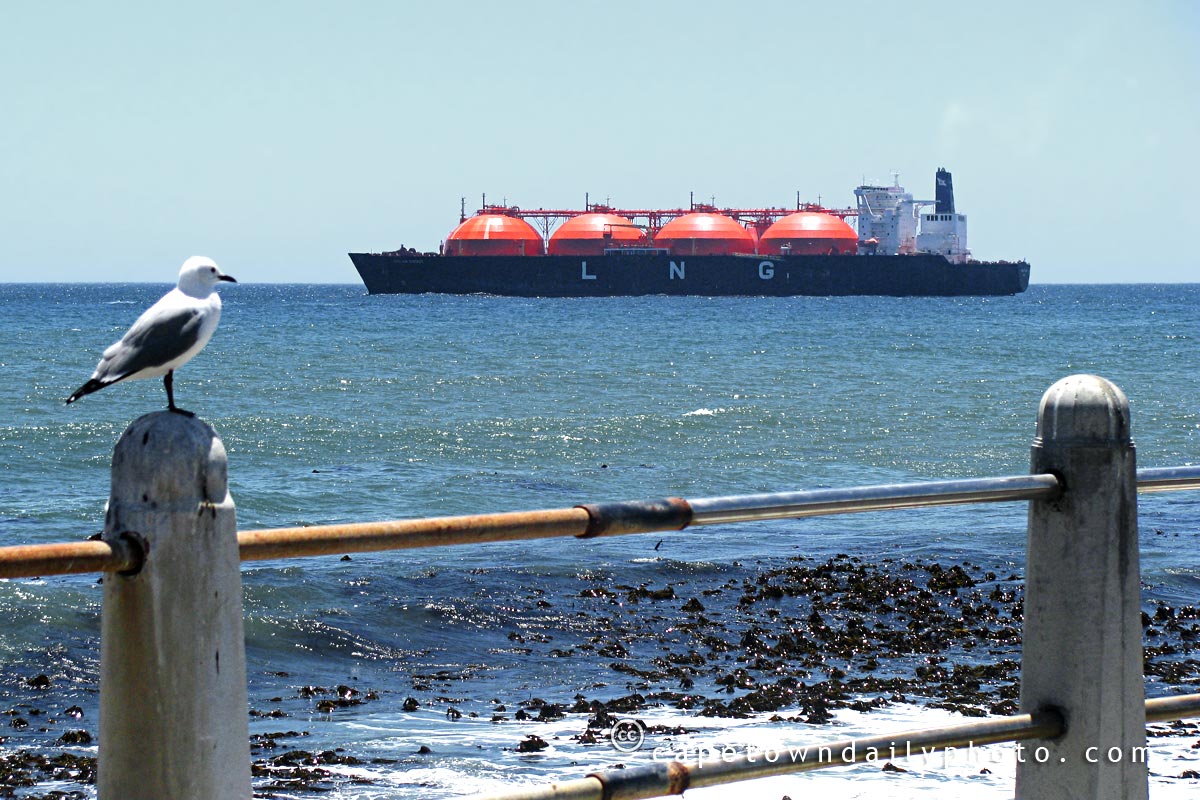
According to the same site, the ships that lie at anchor off the coast like this (we see quite a few of them) are in fact empty, and so these fears were entirely unfounded.
"LNG" stands for Liquefied Natural Gas - natural gas is converted to liquid so that it can be transported, and then returned to its gaseous form once it reaches its destination, so that it can be piped.
This photo was taken from the promenade at Three Anchor Bay.
Robynn Burls
Thanks for sharing that bit of info. I’ve been wondering what these ships are transporting, although it never really puzzled me enough to bother to find out. Mystery solved, thanks.
Beverley
I remember seeing the one last year and we did wonder what they were about..thanks for the info so when I see it this time round I know!!
Gerald
the new site looks good and you’ve kept the old archives which is great.
kevin DC
I was in Cape Town exactly one year ago this week, and I saw one of those ships when I was on top of Table Mountain. I wondered “what the heck is that ship with four orange balls on it?” Thanks for explaining what this ship is.
I love your blog!
ps — I just got home from the inauguration a little while ago! It was one of the greatest days ever! The dreams of Nelson Mandela are alive in Washington DC today! America feels really good right now. (I live in DC so it was just a short bike ride down to the National Mall for me to go to the inauguration ceremony)
Paul
Thanks Gerald, yup – as the site evolves it’ll be kinda nice to see the way CTDP looked when we first started. :)
Hey Kevin – were you visiting on vacation or business, and more importantly did you have a good time? Thanks for the compliment also, and congrats on Barack Obama’s inauguration! Perhaps he’ll be as good for the USA as Nelson Mandela was for South Africa. It’s only his first day and he’s already out doing good. :)
Kai
I see it every day. What more interesting is:
– it is not empty because it is in the water up to the marking line
– why does it stay so long there (at least 5 weeks).
Paul
Kai you make two very good points. I can’t work it out myself.
Pingback:
LNG tankers off Cape Town | alistair.pott
Wayne meyer
Hi All
I hope that all of you know what this ship carries. LNG is some of the most explosive substance known to man kind. If this gas (stored at -160 degrees celcius) meets oxygen (air) it ignites causing an explosion which decimates everything within a 5 km radius and is the strength of 55 Hiroshima Atom bombs.
These guys are bringing this gas within harmful reach of our coastline and most people don’t even know what it is. If you are not convinced go to http://www.revag.co.za or search timrileylaw .
Regards
Wayne
Paul
Thanks for the info Wayne,
The following article explains the consequence of a LNG leak in layman’s terms: http://www.marinefirefighting.com/Pages/Newsletters/Newsletter.htm
In a nutshell, the article explains that there’s a reasonably small chance that it would ignite, and if a severe catastrophe occurred and the liquefied gas came into contact with water, it could explode, though would not ignite (if I understand the article correctly). The explosion would be detrimental to people and buildings nearby. I’m not sure about the 55 atom bomb thing though… in fact, I seriously doubt this.
If LNG came in contact with air only and were ignited by a bare flame, and was in a 5%-15% mixture with air, then it could ignite and would burn rapidly. It would likely be burned out before fire-fighters arrive on scene. Remember that this gas isn’t stored under pressure… it’s not like a balloon waiting to pop.
In conclusion, I guess there could be a danger involved… as I suppose there is danger involved in transporting petrol along the road in tankers. This said, I’m glad that the LNG tanker seems to keep it’s distance from the shore – just in case. ;)
Johnny B
I work as officer on these ships, and I can tell you they are extremely safe. The spherical tanks that hold the liquified gas are made of aluminium which has a very low crack propagation property at cryogenic temperatures. There are gas detectors in each hold which surrounds the tanks are constantly analyze the atmosphere to give warning of any loss of containment. The tanks are not pressurized and the boil off (cargo evaporating) is burned in the engine room boilers. They stay off Cape Town for long periods probably because they are waiting for cargoes to become available in various parts of the world and South Africa is a good central location to hang around waiting for a cargo.
LNG or liquid methane (CH4) is quite a light cargo so these ships don’t draw large draughts like VLCCs (supertankers) and the draught doesn’t change that much from loaded to ballast condition.
Hope this clarifies some of the questions about LNG carriers.
All the best folks
JB
Kerry-Anne
Post authorJohnny, thanks so much for taking the time to explain all of that – you’ve given us some really great information, and hopefully it will put some people’s minds at ease!